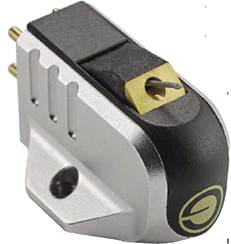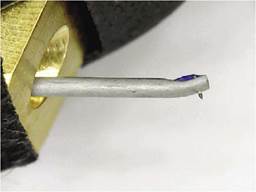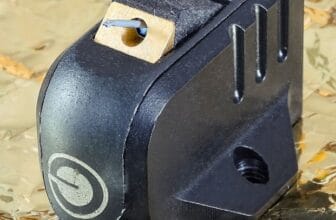GOLDRING ETHOS MC Review – Take It Easy
For an easy sound Goldring’s Ethos moving coil cartridge has little competition, says Noel Keywood.

Once upon a time moving coil cartridges were rare. Ortofon’s SPU is the best known. Released in 1958 it was a heavyweight beast, difficult to use as a result – and because output was low. All the same it gathered a reputation for sound quality, so much so that Ortofon still build a wide range of variants today, some coming in at the cost of the Goldring Ethos moving coil cartridge I am reviewing here.
Goldring, established even earlier in 1906 they say, have also been making phono cartridges for a long time, and today have many moving coil types. But these days the moving coil has become a lot more popular: it is, relatively speaking, now within financial grasp – and bulky, expensive step-up transformers are unnecessary; transistors do the job instead. That means there are a lot out there, giving buyers broad choice.
Before talking specifics about the

Gold plated output pins were fractionally larger diameter than many, needing a firm push to get the connectors on.
Ethos, I need to put it into market context. Moving coil cartridges always had the advantage of flat frequency response and therefore a more insightful sound than less
“The Ethos worked its way through confidently: Rosella Caporale was in firm form against a smooth, silent background”
expensive moving magnet types. The SPU was used in professional environments like broadcast radio stations as a result.
Until recently it was moving magnet cartridges that gave the classic warm sound of vinyl, because their output falls away at high frequencies. MCs gave a clearer, more accurate sound.
Modern moving magnets have closed the gap, aided by stronger magnets – especially Neodymium – so differences are not so great any more. For example, the Audio Technica VM750 SH MM I use is every bit as flat in response as an MC – no vinyl warmth.
What to do if you want a bit of vinyl warmth? There aren’t so many choices left. Shure’s M97xE is one way to go, another being Audio Technica’s AT-3600. Drawback? They are both budget MMs. For those after the more spacious moving coil sound, where stage depth and clarity come to the fore, there’s just about nowhere to go because moving coils don’t come with warm vinyl sound.
Except here: Goldring’s Ethos. Before getting onto sound quality then I’ve let the cat out of the bag, necessary with the Ethos because as moving coil cartridges go it is sonically different.
Like so many others now, the Ethos comes in a machined alloy body with tapped screw holes for easy fixing. The holes are open-ended so long screws can be used if need be. Goldring supply 6mm long screws

A front view of the Vital diamond stylus shows cleanliness of bonding to the crimped cantilever end.
as standard, plus very short 4mm screws, both stainless steel with hex heads and accompanying hex key.
The long screws suit SME, Rega type headshells, the short screws thin pressed metal headshells; those with thick wood headshells will need to buy longer screws.
Fixing the Ethos was easy enough, but with a few wrinkles. The connecting pins seem to be a bit on the big side – I had to push hard to get our SME connectors to fit, using fingers to feel the force needed and prevent damage. The use of snipenosed pliers would likely lead to bent pins.
Then, after getting the Ethos into place, I attempted to pull the stylus guard off and it promptly sprang back; for a short moment I thought the stylus cantilever was a gonner, but luckily it wasn’t. This strange behaviour was down to a thin, clear elastic band holding the clear plastic guard to the body, not something I’ve come across before. If the band had been red or black I would have seen it.
Such funnies apart, the weight of

The cantilever tube is a conventional lightweight aluminium type. Both Ortofon and Audio Technica, amongst others, now offer more advanced tapered tubes and Boron rods.
7.5gms is perfect for arm compatibility: it can be balanced out in just about any arm since they all accept 6gm-10gm weight range. Parallel sides made alignment in the headshell easy too. The stylus cantilever is a straight aluminium tube, with a Vital profile stylus for accurate groove tracing; it worked well on the short mechanical wavelengths of inner grooves measurement showed. Tracking force is quoted as l.75gm optimum with 2gm maximum. Tracking was good at l.75gm but I chose 2gm for a little bit more security in the groove.
SOUND QUALITY
I fitted Goldring’s Ethos to the SME309 arm of our Timestep Evo modified Technics SL-I2I0 Mk2 Direct Drive turntable. Connection was to our Icon Audio PS3 Mk2 valve phono stage with MC input transformers. Loudspeakers were Martin Logan ESL-X hybrid electrostatics driven by our Icon Audio Stereo 30SE single-ended valve amplifier. I also used the Pro-Ject RS2 phono stage feeding a Creek iA20 amplifier for a more representative solid-state sound.
Aware Goldring MC cartridges have tight, punchy bass I put on Sing, Sing, Sing, a live direct-cut from the Syd Lawrence Orchestra, from their LP Big Band Spectacular. The live-

Our close-up side view shows clearly the stylus is neatly bonded into place on a parallel sided aluminium cantilever tube.
miked (no synths!) fast drumming presents a challenging test, one the Goldring managed very well. Helped, I suspect, by its one-piece alloy body, the drums were engagingly dynamic and powerful, inevitably sitting in clearest studio space (the band recorded this live in a studio, direct cut to disc) through our minimalist valve system. Drum strikes were solid if a tad softer than I am used to; cymbals rang sweetly but did not jump from the mix. Straight away I flagged up “easy going” in my mind, but with fluid bass and a deep sound stage revealed by the valve system. Subsequent measurement confirmed what was sonically obvious, rolled down upper treble.
With Neil Young’s After the Goldrush, a recent all-analogue re-master from master tapes, Tell Me Why had his vocals clear centre stage, against a lullingly quiet background, the stage having good sense of depth in true MC fashion. This LP has quite a bright balance, making his (Nils Lofgren’s?) close-miked guitar strings vivid – extraordinary considering it’s a 1970s recording. I know the strings on this outer groove cut out, but the Ethos muted them, making for easy listening. The flip side to this was similarly muted groove noise and unintrusive ticks and pops.
This suited Marianne Thorsen playing Mozart Violin Concertos, where LP surface noise – what little there is of it on a fine recording from 2L of Norway – was barely apparent. For Classical enthusiasts then the Ethos is a very good choice, since Classical has less high frequency energy than Rock, being less obviously affected by the high

An attractive milled aluminium body with open-ended, threaded screw holes – no nuts needed. Parallel sides make alignment easy.
frequency roll down..
The Vital stylus traces inner grooves well measurement showed – and I heard this with my favourite inner groove test track, Time To Say Goodbye from the LP Two Countries One Heart. A superbly balanced recording from HiFi Direct of Italy, the Ethos worked its way through confidently, delivering Rosella Caporale in firm form against a smooth, silent background. Again, the easy going nature of the Ethos was a hidden benefit: if you love vocals and don’t want to be shot at by ticks and pops this is your man (or woman!).
Certainly, I heard total contrast to Audio Technica’s Super Line Contact (SLC) top stylii that make a tin hat necessary with noisy LPs, but difficult to choose between the two approaches. Goldring’s Vital tip profile retrieves high frequencies but with level – 5dB down compared to MCs from other manufacturers it is inevitably going to sound reticent in delivery – and it did.
Of course, if you have a bright system it will help balance things out.
CONCLUSION
Goldring’s Ethos is a moving coil cartridge unlike most else. It offers

Short (4mm) and long (6mm) stainless steel fixing screws. Thick wooden headshells will need a longer screw.
moving coil clarity and stage depth but has a lullingly smooth sound, as we know it from vinyl days of yore. A good performer all-round, with fine tracking, it’s an alternative to the more challenging sound of today’s current crop and worth considering.

A clear shot of the aluminium cantilever shows how these items are made, having a crimped end to accept a bonded nude stylus in this case.
MEASURED PERFORMANCE
Our frequency response analysis, measured with JVC TRS-1007 – an industry standard test disc – shows the Goldring Ethos measured flat from 20Hz to 1kHz before rolling down slowly above this frequency to become -2dB down at 10kHz and -6dB down at 20kHz. Since today’s MCs commonly run flat to 20kHz the Ethos will subjectively have a less bright sound than most.
The Vital stylus traced inner grooves very well the red trace shows, with no loss up to 10kHz and just -1dB above that. However, output is still -6dB at 18kHz so there will be warmth in the sound, if little inner groove distortion due to absence of harmonics.
Tracking was very good at the recommended 1.75gm downforce, a high 63muym cut being cleared, but there was some mistracking of the top 90muym cut of CBS STR-112 test disc (300Hz). Increasing downforce to 2gms minimised this.
The top torture track (1kHz) of B&K QR2010 test disc few cartridges clear but the Ethos stayed in the groove and mistracking was slight with 2gm downforce. In all, good results.
Channel separation averaged out at 26dB and output averaged out at 0.4mV (3.54cms/sec), both reasonable figures. Output is not high but sufficient for modern MC phono stages.
Distortion measured 1% lateral (CBS-STR112, 45muym) – good. This rose to 3% on vertical modulation due to a high measured vertical tracking angle (VTA) of 28 degrees (DIN 45 542 test disc). The ideal is 22 degrees.
The Ethos measured well but it will have a perceptibly soft sound due to high frequency roll down. NK


GOLDRING ETHOS MC
OUTSTANDING – amongst the best
VERDICT
Read our MOVING-COIL CARTRIDGES GROUP TEST
Armour Home Electronics +44 (0)1279 501111 www.armourhome.co.uk





